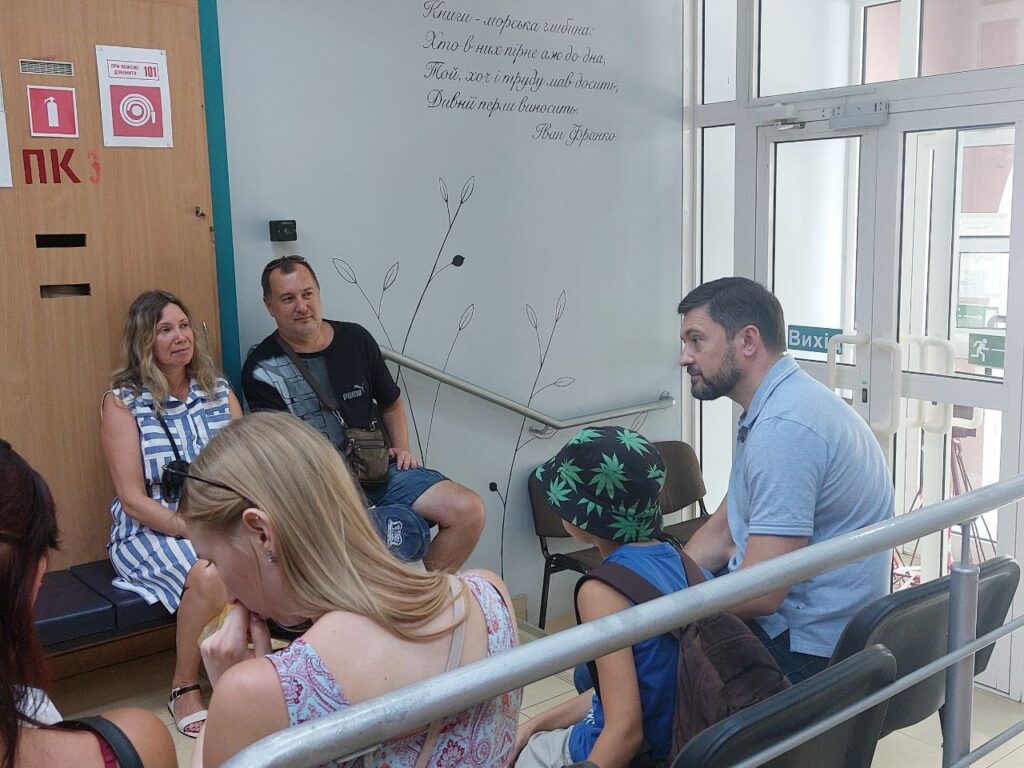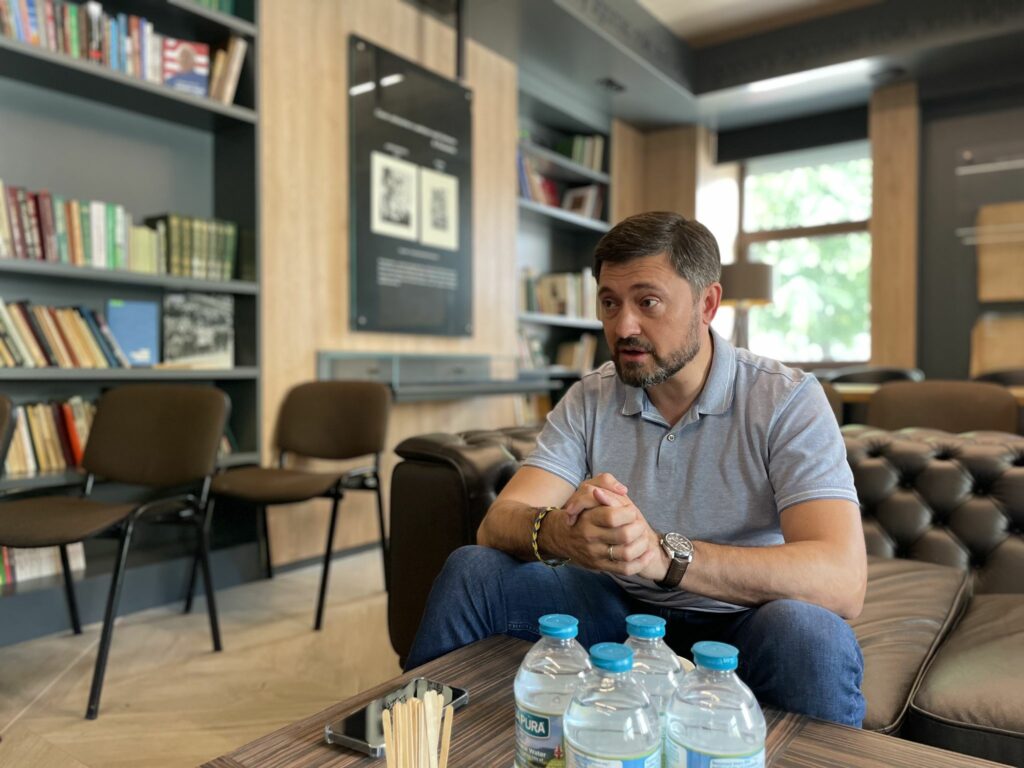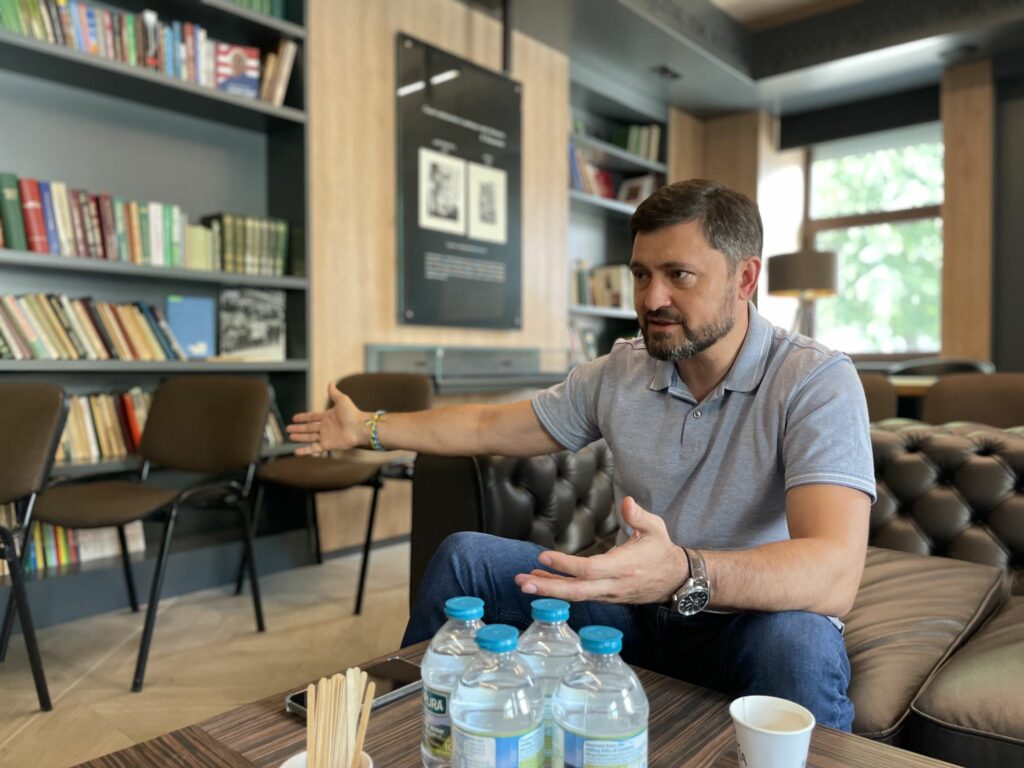The Mariupol urban territorial community was formed in July 2020. It includes 11 settlements. Before the war, 446 thousand people lived on the territory of 377 square kilometers. Most of them were located in Mariupol, one of the industrial centers of the country. Just a year ago, two huge metallurgical plants and a seaport, one of the five largest in Ukraine, were successfully operating in the city.
What is happening to the city today? Will its residents return home after de-occupation? We asked Mariupol’s mayor Vadym Boychenko this and more.

Vadym says that Mariupol was the first in many ways even before the war. Unfortunately, the city happened to be the first to meet the enemy’s fist in February 2022. And now the city is the first to implement a unique program to support its residents. All because Mariupol is not a territory, but people.
Now the city is scattered throughout the territory of Ukraine and further to the West. A city without a place. Therefore, the mayor has to travel across Ukraine often to support the citizens who were forced to leave Mariupol. By the way, no other residents of the destroyed cities of Ukraine have such degree of support.
It is always more difficult for the first, because the first makes mistakes that allow others not to repeat them. According to Boychenko, his main mistake (like many others in Ukraine) was disbelief in war.
“Because of that, we lost a lot of time,” he says, “and didn’t do what we had to do to prepare. We should have been preparing for this war all 30 years of independence. Of course, many did not understand this, just like me. But there were people in the country who understood. However, they didn’t do anything either.”
The mayor is convinced that the window of opportunity was not used in the period from 2014 to 2022. Eight years is enough to prepare the cities, rearm the army, purchase air defense systems and modern heavy weapons. If we did that, we would have had fewer losses at least.
“We had these eight years to be ruthless to the fifth column. And we flirted with them, allowed them to work, to promote the “Russian world”, instill faith in great Russia. If they were eradicated, the Russians would have no one to rely on in the occupied cities. After all, those who brought the so-called “Russian Spring” in 2014 are the same people who sit in the occupation administration in Mariupol now. We, as representatives of the Ukrainian authorities, allowed them to work, all these Shariy, political parties such as “Opposition Platform — For Life”, etc. The price of these mistakes is very high. As for Ukrainization and decommunization, these were absolutely correct steps. And the fact that first of all the Russians began to return all of that speaks of exactly the same: To move on, it is necessary to eradicate Sovietism from ourselves. However, Ukrainians proved that they know how to fight. Putin still hasn’t succeeded in what he planned to do before the beginning of March. And I am proud of my country and my compatriots,” Vadym Boychenko admits.

The war put all the dots above the “i” in the question of what Russia is. Russia is not a friend, not a brother under no circumstances. It is a mean and very cruel neighbor. And it will always be like that. Therefore, we should always be ready for this and continuously work on security.
Managing Mariupol today, after the economic leap made by the city in recent years, including due to the local self-government reform, is extremely difficult. As soon as martial law was imposed in the country, the entire system of governance was restructured. Now decentralization is limited. The treasury is not working as it should be. Only two basic needs are covered: wages and payments to displaced persons. There is a $5 billion gap in the state budget. Therefore, it is not a time to talk about development.
“We have an income of just 40 to 60 million hryvnias” says Boychenko. “When I look at our budget plans that we made for this year, which is 4.5 billion, I am very sad. Mariupol’s budget now has a single source of income – military units. They continue to pay taxes. True, some units have re-registered in other cities, but we are working on returning them. Therefore, all the “I am Mariupol” centers that we are opening in different cities of Ukraine are opened without budget money. Because there simply wouldn’t be enough of them. Our partners and friends help us.”
Answering the question “How did the idea of creating such hubs come about?”, the mayor notes thatideawas simple: there are people, our people, who are in trouble, and we must use all available opportunities to help them.
“We had experience working with displaced persons in 2014-2016. And we used it, transformed it, adapted it to the new situation. This is how “I am Mariupol” was born. These centers are made possible thanks to our international partners. The opening of each center begins with the work of the Save the Children team, which defines the concept. The Heks company, as well as the Rinat Akhmetov Foundation, provide hygiene products. World Central Kitchen deals with food products. Every month, this American company spends about 1 million dollars on food kits for Mariupol relief centers”, says Boychenko.
The centers help residents of Mariupol who have left the city to socialize, adapt to new conditions and keep faith in themselves and their country. A lot of effort has been focused on this, because the issue of evacuation has ceased to be relevant. Although at the very beginning, the evacuation of people was the number one task.
The mayor remembers that it wasa real shock for everyone, when in just 5 days the city was put under a complete blockade. And just 5 days after the start of the large-scale invasion, it was necessary to start negotiating with Russia about the liberation of people.
“No one expected this. No one! – he emphasizes. – Now, having the experience of Mariupol, the heads of military administrations are announcing the evacuation. But in February, no one understood that this was necessary, because they did not even imagine that Russia could simply destroy cities, wipe them off the face of the earth, kill people by the thousands. We all became hostages of 2014. We thought it couldn’t get any worse. Therefore, at the beginning of the war, we were calming people down, instead of urging them to evacuate. There was no order. There were no conditions for evacuation. The city council had no authority to evacuate. There was no understanding that it was necessary. There were evacuation trains until the tracks were bombed. People did not want to go, the trains left Mariupol empty. But starting from March 1, when the Russians blockaded the city, we started exhorting to the whole world and knocking on all the doors: save the people of Mariupol. And already on March 5, they made the first attempt to organize the deportation of Mariupol residents. Unfortunately, it failed.”

For many people who were able to evacuate it later, now the main problem is work. Mariupol City Hall has started working with a professional recruiting agency that helps create a database of vacancies. This is implemented on the example of the Dnipro. In parallel with the vacancy database, a database of people who potentially need work is created. The creation of a platform that will help find all possible employment options within the city began on July 1. Vacancies in settlements bordering this city are offered as well. Training/education is offered according to necessity as well.
Another important problem is housing.
According to Boychenko, the project aimed at reconstruction of dormitories into small apartments for families who urgently need help is starting:
“The idea of the project is as follows. The cities of compact residence of displaced persons transfer student or other dormitories, which are not used due to their unsatisfactory condition, to the Mariupol City Council for temporary use. The Mariupol municipality is converting them into modern small apartments for the families of Mariupol residents. People will live there and pay only utilities. After the liberation of Mariupol and the reconstruction of housing, these people will be able to return to the city, and the dormitory will return to its previous owner”.
The benefit for the city that provides the dormitory is that in a year or two it will receive a modern, renovated building that it can use at its own discretion, without spending money from the local community. Mariupol will have the opportunity to settle people and at least partially solve the most pressing issue of all displaced people. The International Organization of Migrants agreed to finance the project. So there will be no budgetary funds in this story either. Reconstruction projects for 10 dormitories have already been promptly prepared. We agreed on the idea with the Minister of Education Serhiy Shkarlet. We have already received two dormitories for reconstruction – one each in Dnipro and Vinnytsia.
Offices providing communal and social services to Mariupol residents will be on the first floor of these dormitories. Dentists, psychologists, sewing workshops, hairdressers, dry cleaners, co-working spaces, etc. These will not be just service offices – they will become additional workplaces for the residents of Mariupol. Those who will work in these institutions will receive housing first.
Each apartment will have its own bathroom, shower, and small kitchen. The apartments will be small but contain the necessary minimum of communal comfort.
The mayor is not afraid that people will not want to return to Mariupol after getting housing and work in a new place.
“Maybe it will sound pathetic, but I really think so”, he explains. “Mariupol is in the heart. This is a special city, and the people living in it are special. Once the city is liberated, I’m sure people will return to rebuild it. And that is why we are already taking an active part in the development of the government draft law No. 7198 on reparations for people who have lost property. We made our suggestions. And people’s deputy Yaroslav Zheleznyak from Mariupol is advocating now for our position to be heard and considered. We are trying to achieve priority compensation for the residents of Mariupol. We are already preparing to return.
When you watch the footage from the destroyed city, you somehow do not believe that it will be possible to revive it. But listening to Vadym Boychenko, there is no doubt about it. Together with his team, he is developing a strategy for the recovery of Mariupol. A separate concept is being developed for each district of the city.
It will be a modern city. Accessible. More secure. Comfortable. With completely new architecture. A city that’s attractive for tourists and IT enthusiasts. The concept of “City by the sea with an ocean of opportunities”, by the way, is not abandoned.
“I believe that Mariupol will be liberated in December-January. Then about two months will be spent on demining. In the spring, we will return to the city and start building it. We will build a safe city, but the state will also have to review its security policy in order to prevent the recurrence of war,” the mayor said.
He wants to celebrate the first day after the war together with the Armed Forces of Ukraine in Mariupol. He recalls that something like this has already happened in his life:
“On June 13, 2014, I stood on the corner of the Peace Avenue, near building 43, preventing people into the territory where the Azov regiment was conducting an operation for Mariupol liberation. I want to be there, in the heart of Mariupol, when the Armed Forces liberate the city again.”
Anna Murlykina, Mariupol-Dnipro
07/11/2022
The material is prepared within the project “Countering Disinformation in Southern and Eastern Ukraine” funded by the European Union.



